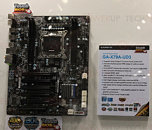Monday, May 30th 2011

Gigabyte X79 UD3 LGA2011 Motherboard First Shot
Here is the first picture of GA-X79A-UD3, the first Gigabyte-branded socket LGA2011 motherboard. Based on the Intel X79 Express chipset, the board supports upcoming Sandy Bridge-E enthusiast processors in the LGA2011 package. Mind you, this is just the cheapest LGA2011 board from Gigabyte, there is a higher-end line of X79 motherboards, so don't let the unspectacular looks of the UD3 get you.
The GA-X79A-UD3 is a standard ATX sized motherboard. Its main VRM is spread all around the large CPU socket, in what appears to be a 6-phase design, with an unknown number of memory and uncore phases. LGA2011 processors feature a large quad-channel DDR3 memory controller, along with a northbridge uncore component with a 40-lane PCI-Express 3.0 controller. Those amount to the socket's insane pin-count of 2,011 pins. Memory slots are located in pairs of two on either sides of the socket. Each slot is its own 64-bit wide memory channel.Expansion slots include five PCI-Express 3.0 x16, from which we suspect four are wired to the processor, and one to the X79 PCH. There's a legacy PCI slot, too. The X79 PCH is loaded with a 10-port SATA 6 Gb/s RAID controller, all 10 ports are internal, an additional 2-port SATA 3 Gb/s controller is also integrated into the PCH, with its ports being assigned as internal.
Since this is the UD3 (entry level) model, its connectivity is rather skimpy, with 8+2 channel HD audio, a number of USB 3.0 ports, USB 2.0, and a single gigabit Ethernet.
The GA-X79A-UD3 is a standard ATX sized motherboard. Its main VRM is spread all around the large CPU socket, in what appears to be a 6-phase design, with an unknown number of memory and uncore phases. LGA2011 processors feature a large quad-channel DDR3 memory controller, along with a northbridge uncore component with a 40-lane PCI-Express 3.0 controller. Those amount to the socket's insane pin-count of 2,011 pins. Memory slots are located in pairs of two on either sides of the socket. Each slot is its own 64-bit wide memory channel.Expansion slots include five PCI-Express 3.0 x16, from which we suspect four are wired to the processor, and one to the X79 PCH. There's a legacy PCI slot, too. The X79 PCH is loaded with a 10-port SATA 6 Gb/s RAID controller, all 10 ports are internal, an additional 2-port SATA 3 Gb/s controller is also integrated into the PCH, with its ports being assigned as internal.
Since this is the UD3 (entry level) model, its connectivity is rather skimpy, with 8+2 channel HD audio, a number of USB 3.0 ports, USB 2.0, and a single gigabit Ethernet.

29 Comments on Gigabyte X79 UD3 LGA2011 Motherboard First Shot
buttload more lab501.ro/wp-content/uploads/2011/05/x79a.jpg
black motherboard? can they use other color than black?
Maybe I will go Intel for my next build when my 1090T becomes 'slow'.
that's insane :D
I can't wait to see the -EXTREME (or -UD7) versions :)
im a fan of this board already.
I heard Intel are going to release a water cooler like Corsair's H70 but if you have a quality heatsink like Noctua/Thermalright/Prolimatech etc you probably just need a new bracket for like $15
the CPU is STRADDLED between the ram slots. WHY? better for latency?!
HOLY COW!!!! I can't wait to see what the UD9 would look like. It's possible that UD9 motherboard model could be a XL-ATX or HPTX form factor but who know.....
This looks like a much better design,the bracket is joined to the socket.
Theres 2 CPU retention levers as well, one on each side...
... or should I? :)
Why is everyone cheering that the board has 14 SATA ports? How many of those ports will you actually be utilizing most of the time?
I am an enthusiast that has a ton of hard drive space but I never utilize more than 6 SATA ports...EVER.
If this is the entry-level board, who is it aimed for? The gamer that needs 28 TB of space? (This is assuming a 2TB hard disk per SATA port)
Is everyone happy because the 14 ports demonstrate high bandwidth availability? I don't really get it...
Besides, it's not only about capacity. It's also about RAID. Imagine if you could stripe ten 60 GB SATA 6 Gb/s SSDs (amounting to ~$1100) in RAID 0. With 8 GB/s chipset bandwidth at its disposal, you could very well be achieving godly speeds restricted to tens of thousands of dollars worth SSD cards.